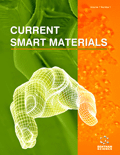Abstract
Background: Recently, core-shell typed electrorheological particles have been developed and become a research focus. In this work, monodisperse polystyrene/poly(2-methylaniline) core-shell microspheres were prepared and the shell morphology were adjusted to either smooth or urchin-like. Therefore, the influence of surface morphology on electrorheological effect was studied by comparing the electrorheological properties of the two kinds of core-shell microspheres.
Methods: The surface morphology of microspheres was adjusted by using different initiators and the products were observed by scanning electron microscopy. Their electrorheological properties were tested by a rotational rheometer. Results: Sea urchin-like shells can be obtained by using iron (III) nitrate nonahydrate as an initiator. While ammonium persulphate could generate a high density of polymerisation centres, and smooth surfaces can be readily formed. In the shear flow curves, the sea urchin-like particles showed much higher shear stress than the particles with smooth surface. In the dynamic sweep tests, the sea urchinlike particles exhibited broader linear viscoelastic region and higher storage moduli under electric field. Conclusion: The low oxygen potential of the ferric salt leads to the growth of poly(2-methylaniline) nanofibres, while ammonium persulphate with a higher oxygen potential tends to form a smoother surface. The sea urchin-like polystyrene/poly(2-methylaniline) particles showed higher electrorheological properties. This indicates that the sea urchin-like particles can generate larger drag force and interparticle friction due to the rough surface and larger surface area of the sea urchin-like particles.Keywords: Core-shell microsphere, electrorheological fluid, friction, sea urchin-like, surface roughness.
 18
18





